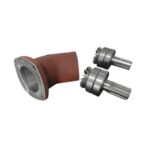
Introduction
When it comes to CNC machining, selecting the optimal material is crucial for achieving desired performance, durability, and cost-effectiveness.
Aluminum and stainless steel are two popular choices, each offering unique advantages and applications. In this comprehensive comparison, we delve into the characteristics, benefits, and applications of aluminum CNC and stainless steel CNC, helping you determine which material is better suited for your machining needs.
Properties and Characteristics
Aluminum CNC:
- Lightweight: Aluminum is significantly lighter than stainless steel, making it ideal for applications where weight reduction is critical, such as aerospace and automotive components.
- High Machinability: Aluminum alloys exhibit excellent machinability, allowing for faster cutting speeds, reduced tool wear, and higher productivity in CNC machining operations.
- Corrosion Resistance: Aluminum naturally forms a protective oxide layer, providing inherent corrosion resistance, although certain alloys may require additional surface treatments for enhanced protection.


Stainless Steel CNC:
- Superior Strength: Stainless steel boasts higher tensile strength and durability compared to aluminum, making it suitable for heavy-duty applications requiring robust components.
- Excellent Corrosion Resistance: Stainless steel is highly resistant to corrosion, making it ideal for applications in harsh environments or exposed to corrosive substances.
- Heat Resistance: Stainless steel maintains its mechanical properties at elevated temperatures, making it suitable for high-temperature applications such as industrial equipment and machinery.
Applications and Industries
Aluminum CNC:
- Aerospace Components: Aluminum’s lightweight and high strength-to-weight ratio make it a preferred choice for aircraft structural components, such as fuselage panels and interior fittings.
- Automotive Parts: Aluminum is widely used in automotive manufacturing for engine components, chassis parts, and lightweight body panels, contributing to fuel efficiency and performance.
- Consumer Electronics: The aesthetic appeal, machinability, and corrosion resistance of aluminum make it popular for producing electronic enclosures, housings, and heat sinks.
Stainless Steel CNC:
- Medical Devices: Stainless steel’s biocompatibility, corrosion resistance, and sterilizability make it suitable for medical instruments, implants, and surgical equipment.
- Food Processing Equipment: Stainless steel’s hygienic properties and resistance to corrosion and contamination make it ideal for food processing machinery, equipment, and utensils.
- Architectural Applications: Stainless steel’s durability, aesthetics, and corrosion resistance make it a preferred material for architectural elements such as handrails, facades, and decorative features.
Cost Considerations
While aluminum typically has a lower material cost compared to stainless steel, the overall cost of CNC machining depends on various factors, including material waste, machining complexity, and surface finishing requirements.
Stainless steel’s superior durability and corrosion resistance may justify its higher upfront cost in certain applications where longevity and performance are paramount.
Conclusion
In conclusion, both aluminum CNC and stainless steel CNC offer distinct advantages and applications in CNC machining. The choice between the two materials depends on factors such as weight requirements, strength, corrosion resistance, heat resistance, and cost considerations.
By understanding the properties, characteristics, and applications of each material, manufacturers can make informed decisions to optimize their CNC machining processes and achieve superior results.
Drop me an email with your ideas, and I’ll get back to you swiftly!



















